

In contrast, voluntary eye movements (i.e., visual tracking of a moving object) involve multiple areas of the cerebral cortex as well as basal ganglion, brain stem and cerebellar structures. The eye blink reflex is the simplest response and does not require the involvement of cortical structures. In this chapter we will start at the level of reflex responses and move onto more complex voluntary responses in the following lecture. The complexity of the circuitry (the chain or network of neurons) controlling a ocular motor response increases with the level of processing involved in initiating, monitoring, and guiding the response. Ocular motor responses include ocular reflexes and voluntary motor responses to visual and other stimuli. Neuromuscular systems control the muscles within the eye (intraocular muscles) the muscles attached to the eye (extraocular muscles) and the muscles in the eyelid. The visual system provides afferent input to ocular motor circuits that use visual stimuli to initiate and guide the motor responses. The ocular motor systems control eye lid closure, the amount of light that enters the eye, the refractive properties of the eye, and eye movements. We use our eyes to monitor our external environment and depend on our ocular motor systems to protect and guide our eyes. They involve the action of few muscles and of well defined neural circuits. If you notice you have small pupils, schedule an appointment with an eye doctor near you to discuss treatment options.The simplicity of the motor systems involved in controlling eye musculature make them ideal for illustrating the mechanisms and principals you have been studying in the preceding material on motor systems. If Horner’s syndrome is to blame, various tests may be required to determine the best course of action. These are similar to the dilation drops your optometrist uses during an eye exam, but they can last up to two weeks. If eye inflammation is the culprit, your eye doctor may prescribe long-lasting dilating drops (atropine or homatropine) to widen your pupils. If a medication is causing it, you may be prescribed an alternative. The treatment will be based on the cause of your abnormal miosis. Neurosyphilis (a bacterial infection in your brain that comes from untreated syphilis).It can also result from chest, neck and brain malformations and a rare type of cancer called neuroblastoma, or a tumor in another part of the body.

Horner’s syndrome has the potential to cause one pupil to be smaller than the other and can be inherited or develop after a neck injury or surgery. The way your brain ‘talks’ to one side of your face, including one of your eyes, is affected by this rare condition. You could also develop glaucoma, which implies there is too much pressure in your eyeball. You may be nearsighted and have difficulty seeing objects far away if you have it. When one or both of your parents pass on an inherited defective gene, this can affect either one or both eyes. Some of the commonly used drugs that can cause miosis are these opioids Ĭontact an eye doctor near you to find out why your pupils may be small.Ĭongenital miosis or microcoria is an inherited condition where the muscle that regulates the pupils or your pupil muscles aren’t properly formed. Narcotics, whether prescribed or illicit, can do the same. Miosis can also be caused by medication side effects.Ĭertain medications for anxiety, muscle spasms and seizures, such as diazepam (Valium) and antihistamines like diphenhydramine (Benadryl), can cause the pupils to shrink. This can occur due to an eye injury or could also be due to a condition known as uveitis, which causes swelling in the iris and the tissues around it. Swelling inside the eye can make it difficult for the pupils to expand. It may be more difficult to see at night as a result.

The muscles that control the pupils can become weak, making it difficult to open them. In old age, the pupils begin to shrink as well. It’s usual for a newborn’s pupils to remain small for roughly two weeks so that their eyes are shielded from strong light. There are many causes of pupils shrinking in size: Age This condition is known as abnormal miosis, and it can affect one or both eyes. If your pupils remain small even in dim light, it could indicate that something in your eye isn’t operating properly. Miosis is a condition where your pupil shrinks or constricts in size. It enlarges to let in more light while you’re in dim light and shrinks to protect your eye and keep light out while you’re in bright light. It grows and shrinks thousands of times per day. Your pupil is the dark circle in the center of your eye. With miosis, the pupils are less than 2mm. Normal pupils are usually 4-6 mm in diameter in room lighting.


 0 kommentar(er)
0 kommentar(er)
